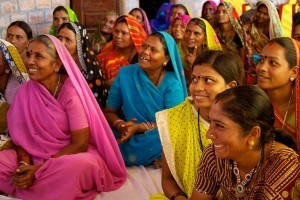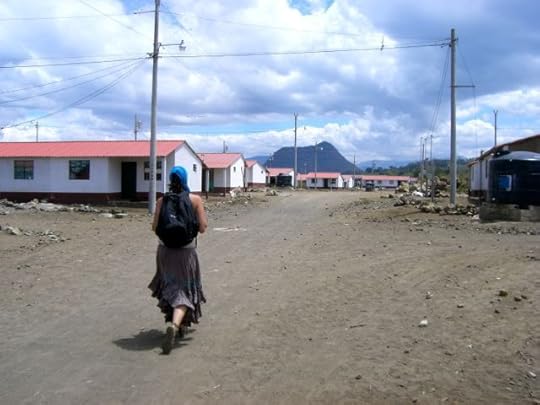Rolf Potts's Blog, page 73
December 17, 2012
Are they to be feared? Who are they anyway?
Vagablogging :: Rolf Potts Vagabonding Blog

Why are we all so afraid of those we don't know?
“I was driving down the road the other day and saw some cyclists ahead. I braked and waited until I could get by safely, but I’m concerned about them – the other motorists who won’t do that.”
“I saw a cyclist riding through my town last week, so I invited him over to my house for the night. I took care of him, but they won’t.”
“I stopped and gave some cyclists Gatorade on a hot day, but they wouldn’t even consider doing something like that.”
I hear stuff like this all the time – isn’t it dangerous to bike around the world with all those bad people out there? All those people who would never help a cyclist or go out of their way to avoid hitting them – they’re everywhere.
What I want to know is this: who are they? Who are those people? They certainly aren’t the people we’ve met.
In our 45 months of full-time bicycle touring as a family, we never encountered them. Instead, we met countless people who invited us to their homes, shared a meal with us, filled our panniers with oranges, and hauled stuff halfway around the world for us. The people we met were of the kind, generous variety of human rather than the ones we see on the nightly news.
Traveling on bicycle made us vulnerable – to both the good and the bad. People could have taken advantage of our vulnerability to rob us or run us off the road – there wasn’t a gosh darn thing we could do if someone wanted to do that. But our experience showed that our vulnerability on the bikes made people want to help us, to take care of us, to reach out and make our journey just a little bit better.
The people we encountered stopped on the side of the road to hand over Coke and chocolate in the middle of a long stretch of nothing. They pulled out a bag of fresh pineapple after we had gone too many days without fresh fruit. They leaned out their car window and shouted, “Would you like to spend the night in my house tonight?”
People handed us the keys to their houses, spent hours helping us solve one problem or another, and sent us emails to cheer us up when we were down. They sent packages of goodies through the mail and brought other packages to us when they went on vacation. They hid Gatorade alongside the road, and rescued us from pouring rain.
In short, the people we met were just ordinary people who were willing to lend a helping hand when they saw the need. The people we met were just like you and me. And still – after 45 months and 27,000 miles – we haven’t met them.
Why are we all so afraid of them anyway?
Nancy Sathre-Vogel is a modern day vagabond and explorer who isn’t afraid to reach the farthest corners of the world. Together with her family, she rode her bike from Alaska to Argentina, a journey that took nearly three years. A teacher by trade, she spent 21 years in classrooms in Honduras, Egypt, Ethiopia, Taiwan, Malaysia, and the Navajo Nation. Now she lives in Idaho with her husband and children. You can follow her adventures at www.familyonbikes.org
Original article can be found here: Are they to be feared? Who are they anyway?
December 16, 2012
The illusion of global interconnection makes travel ever more necessary
Vagablogging :: Rolf Potts Vagabonding Blog
“People say that because of Google Earth and the ‘net, travel is less of a priority. I would say the opposite is the case. The very fact of easy interconnection, and the illusion such contact creates of understanding, makes travel ever more necessary. The world is not what it seems. The peevish person in his T-shirt and blue jeans and sneakers is not necessarily a UCLA student. He might be a separatist in Zamboanga or a Libyan rebel or an Ivorian in a mob in Abidjan or the hotheaded son of an African dictator. Or indeed he might be a man or woman heading to a Bruins game in L.A.”
–Paul Theroux, “Dispatch From a Shrinking Planet,” Newsweek, May 15, 2011
Original article can be found here: The illusion of global interconnection makes travel ever more necessary
December 14, 2012
7 Steps to Planning a RTW Trip
Vagablogging :: Rolf Potts Vagabonding Blog
Planning a long-term trip can seem like an overwhelming process for the first-time round the world traveler. Everyone has their own level of comfort when it comes to how much or little to plan on a trip like this, which is part of the reason BootsnAll re-organized our round the world planning section into seven steps.
No matter where you’re at in the process – just starting your trip planning or wondering about what to do with your stuff when you’re gone, there’s going to be something to help you out.
If you are ready to hit the road or need some inspiration for your route, then check out these five fares that we’ve found on Indie, BootsnAll’s Multi-Stop Trip Planner:
Rolf Pott’s No Baggage Challenge RTW from New York City – $4137: New York > London >overland> Paris > Madrid >overland> Casablanca > Cairo > Johannesburg > Bangkok >overland> Singapore > Sydney > Auckland >Los Angeles >overland> Las Vegas > New York City from $4137 taxes and fees included.
Short RTW from LA – $1651: Los Angeles > Beijing > Paris > Los Angeles $1651 taxes and fees included.
James Bond RTW from London – $4369: London >overland> Florence > Istanbul > Mumbai >overland> Udaipur >overland> Delhi > Bangkok > Nassaau > Kingston > Lisbon > London from $4369 taxes and fees included.
Explore Europe and Asia from Auckland – $3108: Auckland > London >overland> Berlin > Moscow > Beijing > Seoul > Tokyo > Bangkok >overland> Kuala Lumpur > Auckland from $3108 taxes and fees included.
Quick RTW from Chicago – $1904: Chicago > Beijing > Frankfurt > Chicago from $1904 taxes and fees included.
If you are looking for something a little different in your round the world trip, then start planning your trip of a lifetime with our RTW trip planner And don’t forget to sign up for BootsnAll’s RTW newsletter, delivering special deals, RTW trip planning advice, and resources via email every single month. We also have a Facebook fan page and Twitter page, so be sure to like and follow those to keep up to date on all your RTW travel needs.
Original article can be found here: 7 Steps to Planning a RTW Trip
December 13, 2012
Want to travel? Get a degree abroad
Vagablogging :: Rolf Potts Vagabonding Blog

Picture credit: Flickr/David Michael Morris
Usually, vagabonding starts with a separation from our previous existences made up of obligations, 9 to 5 routines and homely surroundings. After the liberation, always generally, someone storms off to a different corner of the globe, makes experiences, meets people, open his perspectives and spends his hard earned money. And always usually, when this hard earned cash gets low, these “someones” have to face a dire decision: find a way to support themselves by staying on the road, or just pack bags, return to their homes, and face a new set of consequences and experiences with a new mindset.
If you choose the first one – as I did -, the road ahead of you may be a bumpy one: the shadow of failure, regret and difficulty will always lurk at your side. And it will make a few things that most likely you would have thus far confined into an extra-travel dimension spring back into the game as a new set of open possibilities. I am referring in particular to one, possibly the most extreme: going back to school. Exactly, you read right: books, assignments, education, supervisors, thesis and blah blah blah. Sounds awful, isn’t it? Possibly. But most likely, I am almost sure that not many of you know that it is exactly by studying that a traveler may start funding his own life abroad. I bring you my own humble example: faced with the opportunity of losing a new important relationship or moving on to a teaching job somewhere else, I decided to look for employment opportunities locally, and they were hard to find for me. One day I met a friend who talked me into getting back to university and pursue an MA. “They give good scholarships” he said, giving me hope to solve my problematic economic situation.
So, I choose a suitable course and went back to school: I applied, waited, had to translate many documents in the local lingo – and this was an adventure itself, I assure you – and finally got accepted: as things usually do not always turn out for the best, I did not get a scholarship, but a smaller source of funding to trade off with some casual employment at the university. I was therefore back on my feet with something to do, some money to pay my bills, and especially, a way to enter the local life like I never experienced before.
I also recently discovered that the same concept of ethnographic fieldwork is, indeed, to travel meaningfully. Why? Simple: it brings a social scientist to research deeply a community/place/subculture with a lengthy, focused involvement. It may reflect the same essence of travelling slowly as you would soak into a culture, experience is subtle meanings, compare the differences, and making it less “other” than what it felt like at first contact. Because after all – and even if I am a culprit as well – it is quite hard to establish deep connections by taking 2 week long trips…
Has anyone else been studying abroad for long periods of time? Did you get funded? How would you describe your experiences, overall? May you compare it to a different form of slow travel? Please comment below.
Original article can be found here: Want to travel? Get a degree abroad
December 12, 2012
Traveling with a wheelchair
Vagablogging :: Rolf Potts Vagabonding Blog
Daily activities, within a comfortable, familiar environment can be interesting enough with a disability. If you spend time in a wheelchair, you know how different surfaces, or slight inclines, can create an immense challenge. Well yes, they may pose a challenge, look at it this way; a world on wheels is a unique perspective.
Not long ago, Justin Skeesuck launched: The Disabled Traveler, with a tag line of “see the world differently.” Justin Skeesuck is a well-seasoned traveler. We connected (via social media) because of our mutual love of photography. I got to be part of the beta stages of his project, and am thrilled to now share with you his live site. On the main page, you’ll discover a free eBook! And every few weeks he hosts an Accessible Travel webinar. But also check out his blog. Where, even I recently discovered another wonderful site with great accessible information and stories called, wheelchairtraveling.com
A lot of the time the worst-case scenario takes over our mind, and it just seems safer to stay home. But hopefully both of the above mentioned sites will help you roll along to discover the world.
Original article can be found here: Traveling with a wheelchair
Vagabonding Field Reports: 6 Months in Sydney – Part 1
Vagablogging :: Rolf Potts Vagabonding Blog

(Sydney - Harbor Bridge)
Cost/day: $75-250 (depending on lodging and meals)
Hello and g-day from down under! How are you going? That last bit, “how are you going” always trips me up – I never know whether to answer to “how are you doing” or “where are you going”. I’ve been living in Sydney since September, and here are a few of the things that I have learned…
What’s the strangest thing you’ve seen lately?
Two things are extremely odd – the proliferation of utes (i.e. the product of car and truck cross-breeding)

(Ford Ute)
and Christmas decorations out on the beach.

(Christmas Decorations on the Beach)
I just can’t seem to get into the holiday spirit when it is 70-90 degrees outside.
Now – once I get into the outback, I’m sure I’ll have plenty of pictures of odd animals. Just remember – everything in Australia is trying to kill you 

(Everything is Trying to Kill You)
Describe a typical day:
My days vary, from spending all day in an office, heads-down — to spending the day on the beach — to mountain-biking at West Head. The days I enjoy the most, though, have been the ones where I’ve been able to meet up with friends to simply share a meal and joke around. I can say that there is something here for everyone – from urbanites to outdoor adventurers.
What do you like about where you are? Dislike?
So far, I’ve spent time in Manly (about 17km north-north-east of Sydney CBD), Darlinghurst, Surry Hills and now back to Darlinghurst. Of them all, I would say that Manly felt the most “Australian”, because I was outside of the city and near the beach; Surry Hills felt the most up-scale and was incredibly convenient; but Darlinghurst is easily the most convenient. From here, I can jump on my bike and make it just about anywhere in 15-30 minutes – from Sydney CBD, to Darling Harbor, Surry Hills and Bondi Beach. I’ve also been able to add a bit of regularity to my life by signing up with local Jiu Jitsu classes and using the Fishburners co-working space.
Describe a challenge you faced:
The biggest real-world challenge is keeping in touch with my friends and colleagues in North America. We live in an incredibly connected world — however, time and distance still create a chasm. Of course, it is nothing like it was 10 years ago, but staying on contact just requires attention to overcome.
Aside from that – it took me about 2 weeks before I could drive (on the wrong side of the road) without constant attention. It isn’t hard on motorways, but a couple of times a simple right-hand turn became “interesting” when entered the right-hand lane. At least everyone seems to be forgiving!
Speaking of driving — do you know how hard it is to obey the speed limits, especially really, really, low ones with constant speed-cameras? Don’t let the metric system fool you – 60 km/h is only 37.28 mph. Now, this isn’t hard when you’re driving a Yaris — but jump into something with a little horsepower, like a Holden, and you feel like you’re tapping the accelerator pedal with a feather to avoid getting a ticket.

(Holden)
Another challenge really hasn’t been faced yet, but I can feel it coming up — Christmas. I’m excited to spend it on the beach, but do miss my core friends and family. We’ll see how it turns out.
What new lesson did you learn?
The most interesting thing about living in APAC so far has been getting to know the various cultures. Some places are very western-accommodating (Australia and Singapore), while others feel more… exotic? Foreign? Either way, that makes them incredibly interesting. This one could fill a post all on its own – so I’ll write more about it later.
The best real-world tip I can give you for Sydney: if you play to stay here for a while, sign up for GoGet (http://goget.com.au) – a car-share service. Bikes or public transit are fine for within the city, but there is soooo much to do and see in the surrounding area. With the high cost of rental cars, petrol (gas) and incredibly high parking (up to $90 AUD per day), it will save you a ton.
One more tip – has been great for finding places to stay. I’ve used it to try out different suburbs and neighborhoods, staying about 3-6 weeks in each.
Where next?
Since I came out in APAC for work, my travel has been limited. Thankfully my life balance is being restored. This weekend I’m headed down to Tasmania with a friend. (Note: MUST find a Tasmanian Devil.) and I have future trips planned to Queenstown, New Zealand (described as a must-go for adventurers and thrill-seekers), Perth and Darwin.
Until then, while you are bundled up on Christmas – know that I will be on the beach somewhere, in board-shorts, celebrating it with a beer. Happy Holidays!
Original article can be found here: Vagabonding Field Reports: 6 Months in Sydney – Part 1
December 11, 2012
On walking and Wanderlust
Vagablogging :: Rolf Potts Vagabonding Blog
“Many people nowadays live in a series of interiors–home, car, gym, office, shops– disconnected from each other. On foot everything stays connected, for while walking on e occupies the spaces between those interiors in the same way one occupies those interiors. One lives in the whole world rather than in interiors built up against it.”
– Wanderlust by Rebecca Solnit
I like to walk. I walk a lot, to do my shopping, to get from A to B, to study a place, to sort out the spaghetti strands of my own mind. We have spent long periods of time living car free, using our feet as our primary means of transportation.
I’ve traveled lots of different ways: by bicycle, in vans, busses, trains, airplanes and on our own two feet.
One thing that is consistently true, in my experience, is that the more slowly I’m moving, the more I’m experiencing.
Walking forces an interaction with an environment that a car isolates me from. Instead of just seeing a place go by from my climate controlled chamber, behind glass, I feel it, I breathe it, I taste it. The texture of a place passes beneath my sandaled feet. I notice the bugs and the flowers. I can hear the rhythm of a place in the drumbeat of city life or the quiet song of a forest path.
I’ve been reading about walking lately. Wanderlust, by Rebecca Solnit is one of the books I’m meandering through. The above quote resonated with me: On foot, everything stays connected. The world isn’t a series of interiors that we move between as quickly as possible, instead, it’s the great outdoors, which is punctuated with interiors that act like cocoons. That idea, of keeping things connected, has renewed my desire to walk and my commitment to keeping my feet on solid ground as often as possible.
I travel to see the world, to learn, to grow as a person in my connections with the physical world and the souls that inhabit it. It’s not a race from home, to office, to gym for me. I’ve given up all three of those concepts altogether, but it isn’t really about the interiors, is it? Because I could easily replace those with hostel, to museum, to airport.
What it’s really about is slowing down, making contact with the earth, and taking the time, mentally and physically, to be in a place. Without rushing. Without judgement. As an observer and a traveler, even if the trip is only to the corner store and back.
Original article can be found here: On walking and Wanderlust
December 10, 2012
Making holidays special for the traveling family
Vagablogging :: Rolf Potts Vagabonding Blog

Santa managed to find us even when camped in the desert of Baja
Holidays are most definitely one of the highlights of everybody’s year. We all have our little traditions we stick to and, as kids, look forward to all of them. I used to measure my years by all the holiday traditions we had: making our own valentines… putting up a shamrock tree… the 4th of July parade… Thanksgiving with Grandma’s Cranberry Salad… opening presents on Christmas Eve… Magical indeed!
What to do for holidays was one of the concerns I had when we made the decision to make travel a long-term lifestyle. We quickly decided the smaller holidays wouldn’t be an issue, but the biggies – we had to think of something! Fortunately, all is well in that department and the kids look forward to holidays just like any other kid in America.
Because we never knew where we might be for any given holiday nor had any idea what the circumstances might be, we learned to be flexible and creative. We strived to make the holidays special, but how that special-ness came was the exciting part of it all!
Santa always managed to find us, wherever we were. As teachers, my husband and I always had Christmas off from work, and we traveled during the holidays. Once the boys came along, we continued with our travels and created new traditions for the holiday.
As we are rarely home for Christmas, we didn’t bother with a Christmas tree or decorating the house, but we always try to make the holiday special in other ways. No matter where we are – whether we’re in the Burmese mountains, a tent in Baja, or our home in Idaho – Santa has always come. There were times when we wondered how, but somehow it always happened.
Our boys have gotten their treats from Santa in a wide variety of manners – from actual Christmas stockings hung up in a hotel room to decorated bags left outside our tent to on top of a pile of grass – but they always wake up Christmas morning to find some kind of treat.
While on our bicycle journey, we created the tradition of decorating our bikes. Every year I bought a bunch of garland and mini-Christmas trees and we enjoyed making our bicycles festive. The boys had a blast decorating them, and we enjoyed having our own little holiday spirit with us no matter we went!
The important thing to remember when traveling with children is to be creative and celebrate the holidays somehow. Your old traditions of holidays at home will influence what you do, but think of new and exciting ways of making holidays special no matter you are. Your kids will always remember them.
What holiday traditions have you created to fit in with your traveling life?
Original article can be found here: Making holidays special for the traveling family
December 9, 2012
One of the flaws of travel books is the assumption of national stereotypes
Vagablogging :: Rolf Potts Vagabonding Blog
“I am not sure I believe in national characters. I think it is nonsense to talk about the French being like this or the Italians like that. I agree that one of the flaws of the travel book is this assumption that there is a national stereotype. What I do like in the English travel writing tradition, and what you find in Robert Byron and Colin Thubron, is the reading of the monuments of the past to interpret the present, which seems to me a different thing. There are continuities with the past in any country and I think that is a very interesting game to play.”
–William Dalrymple interviewed by Tim Youngs, Studies in Travel Writing, 2005
Original article can be found here: One of the flaws of travel books is the assumption of national stereotypes
December 6, 2012
Women Travellers and India
Vagablogging :: Rolf Potts Vagabonding Blog

Picture credit: Flickr/mckaysavage
It may be because I have just watched “Life of Pi”, or because once you go to India, if you loved it, you can hardly get it out of your mind. Anyhow, this week I would like to bring this article to your attention. It is an interesting series of suggestions for women travellers to India.
The author “found India both tough and rewarding in the same breath. And from time to time the experience can seem even more perplexing for girls (we are talking about a country where the metro offers a separate carriage for women), but India also has the potential to offer its female visitors even richer rewards (imprinted with henna and swathed in sari silks it’s impossible not to feel like a princess)”. Fantastic. I think the author has pointed out some interesting essential topics.
In the past 24 months, I have spent 7 in India, and I have grown a particular fondness for its thunderous character. I met fantastic people there, and I have also made some strange encounters. Based on my experience, it was interesting to read about the perceptions of a woman travelling around India, as it is undeniably true: sex makes a big difference in this country.
I have been lucky enough to be the guest of a big number of Indian families of all social strata: the rich, the poor, the excessively posh and the dirt poor. One time, I did not stay with a friend because the double bed provided at his house with no roof already had to accommodate six other family members. But apart for this case, one thing was clear in my personal picture: women and men in Indian society are very different classes of people. A man is advanced by a patriarchal society, and a woman is generally employed as a “slave in the house”, regardless of her social status. The only difference may be the number of maids she has.
And I have to quote directly another important thing the author says: “Perhaps one of the most vital concepts to grasp about India is the importance of dressing respectfully. Regardless of your personal opinion on a woman’s right to wear what she wants, the reality is that clothing is much more conservative in India than it is in the likes of Europe, America, Australia, and other countries that are more liberal in the amount of material required to constitute decency.”
If you are a woman and plan on going to India, please follow this simple advice. Respect for their culture may give you more in terms of experience than the bad memory you will bring home not adhering to these simple rules. I have met more than one foreign woman traveler complaining about the horror of Indian men, the stares, the groping attempts everywhere. Right; but when this comes out form the mouth of a person dressed in shorts and a revealing blouse, I am sorry, I have to disagree as she probably does not realize that she is exactly looking for such a reaction.
In conclusion, go check that article out as it is one good piece of advice. And if any women visitors to India have other interesting suggestions to spare to help make a trip more safe and interesting, please comment below.
Original article can be found here: Women Travellers and India
Rolf Potts's Blog
- Rolf Potts's profile
- 323 followers




